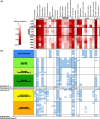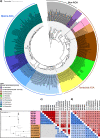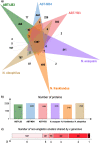Leave no stone unturned: individually adapted xerotolerant Thaumarchaeota sheltered below the boulders of the Atacama Desert hyperarid core
- PMID: 34836555
- PMCID: PMC8627038
- DOI: 10.1186/s40168-021-01177-9
Leave no stone unturned: individually adapted xerotolerant Thaumarchaeota sheltered below the boulders of the Atacama Desert hyperarid core
Abstract
Background: The hyperarid core of the Atacama Desert is an extremely harsh environment thought to be colonized by only a few heterotrophic bacterial species. Current concepts for understanding this extreme ecosystem are mainly based on the diversity of these few species, yet a substantial area of the Atacama Desert hyperarid topsoil is covered by expansive boulder accumulations, whose underlying microbiomes have not been investigated so far. With the hypothesis that these sheltered soils harbor uniquely adapted microbiomes, we compared metagenomes and geochemistry between soils below and beside boulders across three distantly located boulder accumulations in the Atacama Desert hyperarid core.
Results: Genome-resolved metagenomics of eleven samples revealed substantially different microbial communities in soils below and beside boulders, despite the presence of shared species. Archaea were found in significantly higher relative abundance below the boulders across all samples within distances of up to 205 km. These key taxa belong to a novel genus of ammonia-oxidizing Thaumarchaeota, Candidatus Nitrosodeserticola. We resolved eight mid-to-high quality genomes of this genus and used comparative genomics to analyze its pangenome and site-specific adaptations. Ca. Nitrosodeserticola genomes contain genes for ammonia oxidation, the 3-hydroxypropionate/4-hydroxybutyrate carbon fixation pathway, and acetate utilization indicating a chemolithoautotrophic and mixotrophic lifestyle. They also possess the capacity for tolerating extreme environmental conditions as highlighted by the presence of genes against oxidative stress and DNA damage. Site-specific adaptations of the genomes included the presence of additional genes for heavy metal transporters, multiple types of ATP synthases, and divergent genes for aquaporins.
Conclusion: We provide the first genomic characterization of hyperarid soil microbiomes below the boulders in the Atacama Desert, and report abundant and highly adapted Thaumarchaeaota with ammonia oxidation and carbon fixation potential. Ca. Nitrosodeserticola genomes provide the first metabolic and physiological insight into a thaumarchaeal lineage found in globally distributed terrestrial habitats characterized by various environmental stresses. We consequently expand not only the known genetic repertoire of Thaumarchaeota but also the diversity and microbiome functioning in hyperarid ecosystems. Video Abstract.
Keywords: Archaea; Atacama; Hyperaridity; Soil microbiome; Xerotolerance.
© 2021. The Author(s).
Conflict of interest statement
All authors declare that they have no competing interests.
Figures





References
-
- Prigent M, Leroy M, Confalonieri F, Dutertre M, DuBow MS. A diversity of bacteriophage forms and genomes can be isolated from the surface sands of the Sahara Desert. Extremophiles. 2005;9:289–296. - PubMed
-
- Benslama O, Boulahrouf A, et al. Impact of glyphosate application on the microbial activity of two Algerian soils. Int J Curr Microbiol App Sci. 2013;2:628–635.
-
- Cowan DA, Hopkins DW, Jones BE, Maggs-Kölling G, Majewska R, Ramond J-B. Microbiomics of Namib Desert habitats. Extremophiles. 2020;24:17–29. - PubMed
-
- Cary SC, McDonald IR, Barrett JE, Cowan DA. On the rocks: the microbiology of Antarctic Dry Valley soils. Nat Rev Microbiol. 2010;8:129–138. - PubMed
Publication types
MeSH terms
LinkOut - more resources
Full Text Sources

